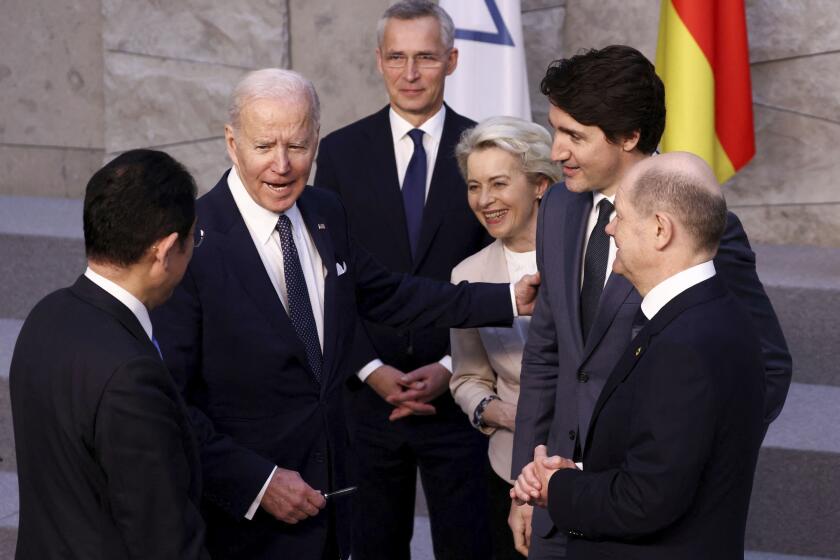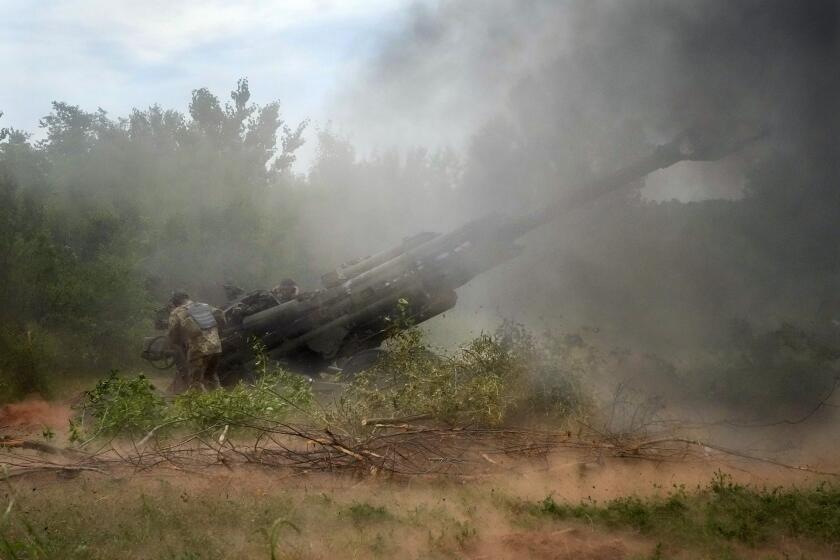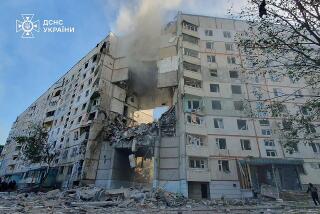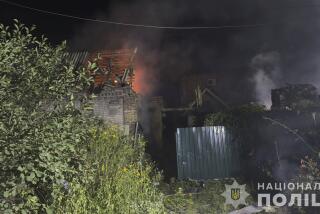Ukrainian troops to retreat from besieged city of Severodonetsk
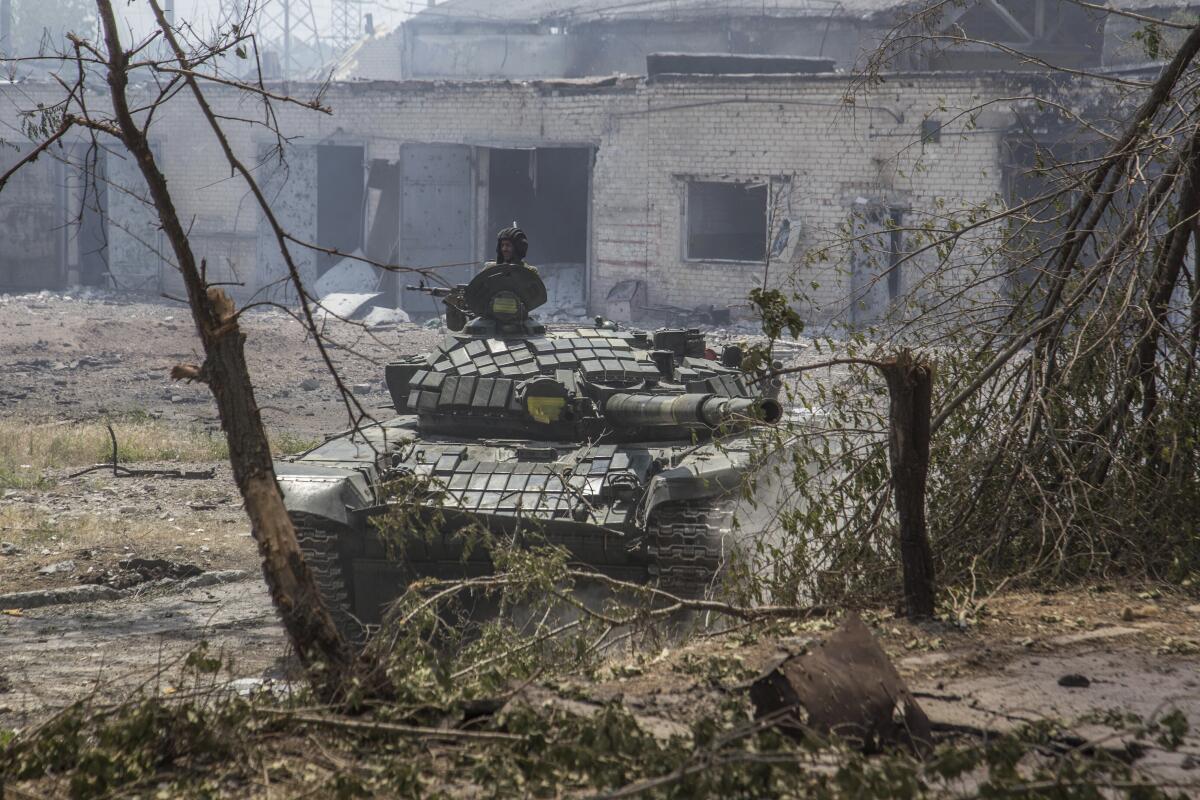
- Share via
A months-long defense that saw Ukrainian troops endure relentless bombardment and ferocious street skirmishes against Russian forces ended Friday when military authorities ordered a retreat from the besieged city of Severodonetsk.
The fall of the industrial city gives Russia almost complete control of Luhansk, one of two disputed provinces, along with Donetsk, that make up the eastern region known as the Donbas.
After a stalled campaign to take Kyiv, Moscow shifted its invasion plans to aim for a full takeover of the Donbas in support of Russian-backed separatists who have controlled sections of the region since 2014.
“Our defenders have already received the order: Ukrainian armed forces will leave the city and move to new, more fortified positions,” Luhansk Gov. Serhiy Hadai said in a Friday post on the Telegram messaging app. “Remaining in positions that have been relentlessly shelled for months just doesn’t make sense.”
It was unclear how a large-scale withdrawal would happen. Russian troops had previously knocked out bridges linking Severodonetsk across the Seversky Donets River to its twin city, Lysychansk, forcing the Ukrainians to use boats to resupply and transport its defenders. The Ukrainian army still holds Lysychansk, which sits on higher ground and is more defensible.
But recent Russian gains on the city’s northern and southern flank — not to mention advances that put the Ukrainians’ escape route to the west under withering artillery barrages — raise the specter of a full encirclement that would trap thousands of soldiers and civilians.
The G-7 and NATO, which hold summits next week, have united in response to Russia’s war in Ukraine. But President Biden and other leaders arrive weakened by inflation and domestic issues, which may curtail the group’s ambitions.
“We stand. We had [deaths] yesterday, but we are still here,” said a special-forces police instructor in Lysychansk who went by the name Alexander.
He didn’t know when the order to withdraw would come, but said he expected it soon. According to an army lawyer, some forces from his group had already left without waiting for an order from their commanders.
The battle for Severodonetsk, the Ukrainian government’s seat of power in Luhansk and the easternmost point of its control, follows the blueprint that both sides have adopted in this phase of the war: for Moscow, unceasing artillery and air bombardment to shatter Ukrainian positions, then Russian troops slowly moving forward to take what remains.
Like in the embattled city of Mariupol, where a Ukrainian garrison in the Azovstal steel plant held out for three months before surrendering in May, the Ukrainians’ strategy has been to stand their ground to the last minute and make every Russian advance a torturous, bloody grind.
Although that strategy has bought time for the Ukrainians to improve defenses in their Donetsk bastions, the costs have been staggering — hundreds of casualties are reported every day.
The Ukrainians have also run the risk of having troops surrounded: On Friday, Russian Defense Ministry spokesman Lt. Gen. Igor Konashenkov said some 2,000 Ukrainian military personnel and fighters, as well as dozens of armored vehicles and heavy guns, had been sealed off around towns south of Lysychansk, according to a report from Russian state news operator Tass.
Another reason for the strategy is to allow shipments of more advanced weapons from Ukraine’s Western partners to reach the battlefield. The U.S. pledged on Thursday to send four HIMARS platforms, which would add to four already delivered to the Ukrainians, who say such multiple rocket systems (MLRS) are vital for blunting Russia’s thrust. Ukraine has received about $6 billion in U.S. equipment since the war began in February.
The result of Russia’s campaign has left Moscow presiding over the smashed remains of what Ukrainian President Volodymyr Zelensky called in a recent speech “dead cities.”
U.S. attorney general visits to offer help in war crimes prosecutions. Moscow says death penalty for purportedly captive Americans can’t be ruled out.
Hadai, the Luhansk governor, said Severodonetsk had been turned almost completely to rubble, with almost 90% of the city damaged and 4 out of 5 homes irreparably so. “[They] will have to be demolished,” he said. “All critical infrastructure has been destroyed.”
Over 85% of residents have fled Severodonetsk and Lysychnask, which each had prewar populations of more than 100,000. The remaining residents are forced to live without electricity, gas and phones.
Because there’s also no water, they line up at the fire station with plastic jugs or trundle down to a stream for it.
Elsewhere in the country, Ukrainian forces claimed to have made advances in the Russian-occupied Kherson province, where Moscow-installed authorities continue to face a wave of sabotage. Russian media said Friday that a car bomb had killed an official in the Kherson regional administration, Dmitri Savluchenko.
More to Read
Sign up for Essential California
The most important California stories and recommendations in your inbox every morning.
You may occasionally receive promotional content from the Los Angeles Times.
